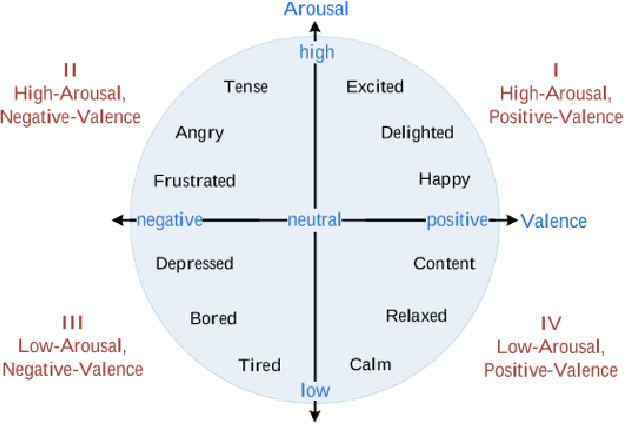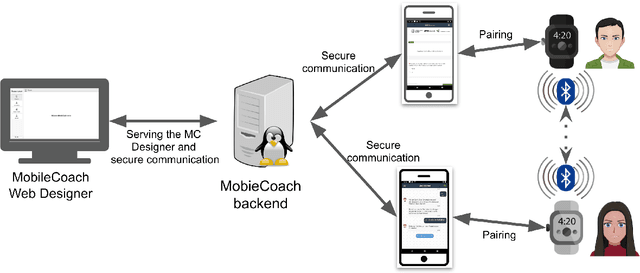Guy Bodenmann
"Are you okay, honey?": Recognizing Emotions among Couples Managing Diabetes in Daily Life using Multimodal Real-World Smartwatch Data
Aug 22, 2022



Abstract:Couples generally manage chronic diseases together and the management takes an emotional toll on both patients and their romantic partners. Consequently, recognizing the emotions of each partner in daily life could provide an insight into their emotional well-being in chronic disease management. Currently, the process of assessing each partner's emotions is manual, time-intensive, and costly. Despite the existence of works on emotion recognition among couples, none of these works have used data collected from couples' interactions in daily life. In this work, we collected 85 hours (1,021 5-minute samples) of real-world multimodal smartwatch sensor data (speech, heart rate, accelerometer, and gyroscope) and self-reported emotion data (n=612) from 26 partners (13 couples) managing diabetes mellitus type 2 in daily life. We extracted physiological, movement, acoustic, and linguistic features, and trained machine learning models (support vector machine and random forest) to recognize each partner's self-reported emotions (valence and arousal). Our results from the best models (balanced accuracies of 63.8% and 78.1% for arousal and valence respectively) are better than chance and our prior work that also used data from German-speaking, Swiss-based couples, albeit, in the lab. This work contributes toward building automated emotion recognition systems that would eventually enable partners to monitor their emotions in daily life and enable the delivery of interventions to improve their emotional well-being.
BERT meets LIWC: Exploring State-of-the-Art Language Models for Predicting Communication Behavior in Couples' Conflict Interactions
Jun 03, 2021

Abstract:Many processes in psychology are complex, such as dyadic interactions between two interacting partners (e.g. patient-therapist, intimate relationship partners). Nevertheless, many basic questions about interactions are difficult to investigate because dyadic processes can be within a person and between partners, they are based on multimodal aspects of behavior and unfold rapidly. Current analyses are mainly based on the behavioral coding method, whereby human coders annotate behavior based on a coding schema. But coding is labor-intensive, expensive, slow, focuses on few modalities. Current approaches in psychology use LIWC for analyzing couples' interactions. However, advances in natural language processing such as BERT could enable the development of systems to potentially automate behavioral coding, which in turn could substantially improve psychological research. In this work, we train machine learning models to automatically predict positive and negative communication behavioral codes of 368 German-speaking Swiss couples during an 8-minute conflict interaction on a fine-grained scale (10-seconds sequences) using linguistic features and paralinguistic features derived with openSMILE. Our results show that both simpler TF-IDF features as well as more complex BERT features performed better than LIWC, and that adding paralinguistic features did not improve the performance. These results suggest it might be time to consider modern alternatives to LIWC, the de facto linguistic features in psychology, for prediction tasks in couples research. This work is a further step towards the automated coding of couples' behavior which could enhance couple research and therapy, and be utilized for other dyadic interactions as well.
"You made me feel this way": Investigating Partners' Influence in Predicting Emotions in Couples' Conflict Interactions using Speech Data
Jun 03, 2021


Abstract:How romantic partners interact with each other during a conflict influences how they feel at the end of the interaction and is predictive of whether the partners stay together in the long term. Hence understanding the emotions of each partner is important. Yet current approaches that are used include self-reports which are burdensome and hence limit the frequency of this data collection. Automatic emotion prediction could address this challenge. Insights from psychology research indicate that partners' behaviors influence each other's emotions in conflict interaction and hence, the behavior of both partners could be considered to better predict each partner's emotion. However, it is yet to be investigated how doing so compares to only using each partner's own behavior in terms of emotion prediction performance. In this work, we used BERT to extract linguistic features (i.e., what partners said) and openSMILE to extract paralinguistic features (i.e., how they said it) from a data set of 368 German-speaking Swiss couples (N = 736 individuals) which were videotaped during an 8-minutes conflict interaction in the laboratory. Based on those features, we trained machine learning models to predict if partners feel positive or negative after the conflict interaction. Our results show that including the behavior of the other partner improves the prediction performance. Furthermore, for men, considering how their female partners spoke is most important and for women considering what their male partner said is most important in getting better prediction performance. This work is a step towards automatically recognizing each partners' emotion based on the behavior of both, which would enable a better understanding of couples in research, therapy, and the real world.
 Add to Chrome
Add to Chrome Add to Firefox
Add to Firefox Add to Edge
Add to Edge